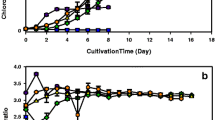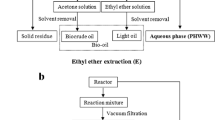Abstract
The feasibility of using a microalga Chlorella vulgaris YSW-04 was investigated for removal of nutrients from piggery wastewater effluent. The consequent lipid production by the microalga was also identified and quantitatively determined. The wastewater effluent was diluted to different concentrations ranging from 20 to 80 % of the original using either synthetic media or distilled water. The dilution effect on both lipid production and nutrient removal was evaluated, and growth rate of C. vulgaris was also monitored. Dilution of the wastewater effluent improved microalgal growth, lipid productivity, and nutrient removal. The growth rate of C. vulgaris was increased with decreased concentration of piggery wastewater in the culture media regardless of the diluent type. Lipid production was relatively higher when using synthetic media than using distilled water for dilution of wastewater. The composition of fatty acids accumulated in microalgal biomass was dependent upon both dilution ratio and diluent type. The microalga grown on a 20 % concentration of wastewater effluent diluted with distilled water was more promising for generating high-efficient biodiesel compared to the other culture conditions. The highest removal of inorganic nutrients was also achieved at the same dilution condition. Our results revealed the optimal pretreatment condition for the biodegradation of piggery wastewater with microalgae for subsequent production of high-efficient biodiesel.





Similar content being viewed by others

References
Abou-Shanab RI, Hwang JH, Cho Y, Min B, Jeon B-H (2011) Characterization of microalgal species isolated from fresh water bodies as a potential source for biodiesel production. Appl Energ 88:3300–3306
American Public Health Association (APHA) (1998) Methods for biomass production. In: Standard methods for the examination of water and wastewater. American Public Health Association, Baltimore, MD
Battistoni P, Pavan P, Prisciandaro M, Cecchi F (2000) Struvite crystallization: a feasible and reliable way to fix phosphorus in anaerobic supernatants. Water Res 34:3033–3041
Bischoff HW, Bold HC (1963) Phycological studies IV. Some soil algae from Enchanted Rock and related algal species. University of Texas Publication 6318:1–95
Bligh EG, Dyer WJ (1959) A rapid method of total lipid extraction and purification. Can J Biochem Physiol 37:911–917
Bruce ER (2008) Opportunities for renewable bioenergy using microorganisms. Biotechnol Bioeng 100:203–212
Chisti Y (2007) Biodiesel from microalgae. Biotechnol Adv 25:294–306
Choi JA, Hwang JH, Dempsey BA, Abou-Shanab RI, Min B, Song H, Lee DS, Kim JR, Cho Y, Hong S, Jeon B-H (2011) Enhancement of fermentative bioenergy (ethanol/hydrogen) production using ultrasonication of Scenedesmus obliquus YSW15 cultivated in swine wastewater effluent. Energ Environ Sci 4:3513–3520
de Godos I, Vargas VA, Blanco S, García González MC, González G, Soto R, García-Encina PA, Becares E, Muñoz R (2010) A comparative evaluation of microalgae for the degradation of piggery wastewater under photosynthetic oxygenation. Bioresour Technol 101:5150–5158
de Morais MG, Costa JAV (2007) Biofixation of carbon dioxide by Spirulina sp. and Scenedesmus obliquus cultivated in a three-stage serial tubular photobioreactor. J Biotechnol 129:439–445
de-Bashan LE, Moreno M, Hernandez JP, Bashan Y (2002) Removal of ammonium and phosphorus ions from synthetic wastewater by the microalgae Chlorella vulgaris coimmobilized in alginate beads with the microalgae growth promoting bacterium Azospirillum brasilense. Water Res 36:2941–2948
Hernandez J, de-Bashan LE, Bashan Y (2006) Starvation enhances phosphorus removal from wastewater by the microalga Chlorella spp. co-immobilized with Azospirillum brasilense. Enzyme Microb Tech 38:190–198
Hu Q, Sommerfeld M, Jarvis E, Ghirardi M, Posewitz M, Seibert M, Darzins A (2008) Microalgal triacylglycerols as feedstocks for biofuels production: perspectives and advances. Plant J 54:621–639
Jeon B-H, Choi JA, Hwang JH, Ji MK (2010) Novel strain Chlorella vulgaris YSW-04, Korea Patent Number 10-2010-0079266
Kabdasli I, Safak A, Tunay O (2008) Bench-scale evaluation of treatment schemes incorporating struvite precipitation for young landfill leachate. Waste Manage 28:2386–2392
Khan M, Yoshida N (2008) Effect of l-glutamic acid on the growth and ammonium removal from ammonium solution and natural wastewater by Chlorella vulgaris NTM06. Bioresour Technol 99:575–582
Lau PS, Tam NFY, Wong YS (1995) Effect of algal density on nutrient removal from primary settled wastewater. Environ Pollut 89:59–66
Lepage G, Roy CC (1984) Improved recovery of fatty acid through direct transesterification without prior extraction or purification. J Lipid Res 25:1391–1396
Li X, Hu HY, Gan K, Sun YX (2010) Effect of different nitrogen and phosphorus concentration on the growth, nutrient uptake, and lipid accumulation of freshwater microalga Scenedesmus sp. Bioresour Technol 101:5494–5500
Liang Y, Sarkany N, Cui Y (2009) Biomass and lipid productivities of C. vulgaris under autotrophic, heterotrophic and mixotrophic growth conditions. Biotechnol Lett 31:1043–1049
Markou G, Georgakakis D (2011) Cultivation of filamentous cyanobacteria (blue-green algae) in agro-industrial wastes and wastewaters: a review. Appl Energ 88:3389–3401
Martinez ME, Sanchez S, Jimenez JM, El Yousfi F, Munoz L (2000) Nitrogen and phosphorus removal from urban wastewater by themicroalga Scenedesmus obliquus. Bioresour Technol 73:263–272
Nelson NO, Mikkelsen RL, Hesterberg DL (2003) Struvite precipitation in anaerobic swine lagoon liquid: effect of pH and Mg:P ratio and determination of rate constant. Bioresour Technol 89:229–236
Ota M, Kato Y, Watanabe H, Watanabe M, Sato Y (2009) Fatty acid production from a highly CO2 tolerant alga, Chlorocuccum littorale, in the presence of inorganic carbon and nitrate. Bioresour Technol 100:5237–5242
Park J, Jin HF, Lim BR, Park KY, Lee K (2010) Ammonia removal from anaerobic digestion effluent of livestock waste using green alga Scenedesmus sp. Bioresour Technol 101:8649–8657
Petkov G, Garcia G (2007) Which are fatty acids of the green alga Chlorella? Biochem Syst Ecol 35:281–285
Pittman JK, Dean AP, Osundeko O (2011) The potential of sustainable algal biofuel production using wastewater resources. Bioresour Technol 102:17–25
Ryu HD, Lee SI (2010) Application of struvite precipitation as a pretreatment in treating swine wastewater. Process Biochem 45:563–572
Tam NFY, Wong YS (1996) Effect of ammonia concentrations on growth of Chlorella vulgaris and nitrogen removal from media. Bioresour Technol 57:45–50
Traviesoa L, Benıtezb F, Sancheza E, Borja R, Martınc A, Colmenarejo MF (2006) Batch mixed culture of Chlorella vulgaris using settled and diluted piggery waste. Ecol Eng 28:158–165
Wang B, Lan CQ (2011) Biomass production and nitrogen and phosphorus removal by the green alga Neochloris oleoabundans in simulated wastewater and secondary municipal wastewater effluent. Bioresour Technol 102:5639–5644
Wang J, Burken JG, Zhang X, Surampalli R (2005) Engineered struvite precipitation: impacts of component-ion molar ratios and pH. J Environ Eng 131:1433
Wang L, Li Y, Chen P, Min M, Chen Y, Zhu J, Ruan RR (2010) Anaerobic digested dairy manure as a nutrient supplement for cultivation of oil-rich green microalgae Chlorella sp. Bioresour Technol 101:2623–2628
Wang H, Xiong H, Hui Z, Zeng X (2012) Mixotrophic cultivation of Chlorella pyrenoidosa with diluted primary piggery wastewater to produce lipids. Bioresour Technol 104:215–220
Zhang L, Jahng D (2010) Enhanced anaerobic digestion of piggery wastewater by ammonia stripping: effects of alkali types. J Hazard Mater 182:536–543
Acknowledgments
This work was supported by the Korea Institute of Energy Research, the Senior Researchers program (the National Research Foundation of Korea, 2010-0026904), the Eco-Innovation project (Global-Top project) of the Korea Ministry of Environment, and the Brain Korea-21 (BK-21) program of the Korea Ministry of Education, Science & Technology (MEST).
Author information
Authors and Affiliations
Corresponding author
Rights and permissions
About this article
Cite this article
Ji, MK., Kim, HC., Sapireddy, V.R. et al. Simultaneous nutrient removal and lipid production from pretreated piggery wastewater by Chlorella vulgaris YSW-04. Appl Microbiol Biotechnol 97, 2701–2710 (2013). https://doi.org/10.1007/s00253-012-4097-x
Received:
Revised:
Accepted:
Published:
Issue Date:
DOI: https://doi.org/10.1007/s00253-012-4097-x



